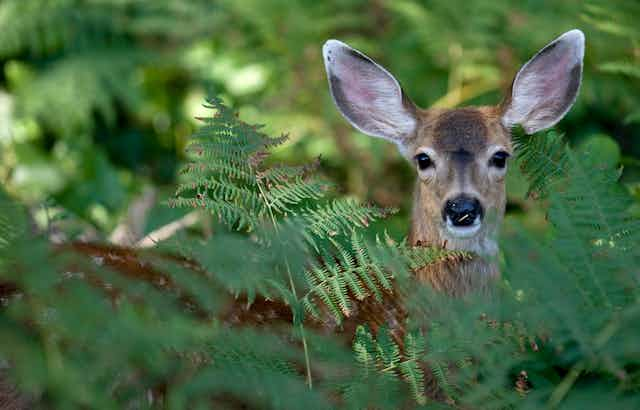Since 1996, a deadly neurodegenerative disease of cervids (deer, elk, moose, caribou, reindeer) has been spreading across Canada.
On Jan. 31, 2024, chronic wasting disease (CWD) was detected for the first time in British Columbia in two deer. In just over half a century from its first detection in the United States, it has since been reported in 32 states, five provinces (Alberta, Saskatchewan, Québec, Manitoba and British Columbia), as well as in Norway, Sweden, Finland and South Korea.
Disease-causing proteins
CWD differs from other diseases, as it is caused by a protein called a prion. The protein is similar to other normal proteins in the body, except it’s abnormally shaped. The abnormal folding of these disease-causing prion proteins — which are found most abundantly in the brain — leads to brain damage that makes the brain appear like a sponge.
Diseases caused by prions in this manner are called transmissible spongiform encephalopathies (TSEs). Other TSEs include Creutzfeldt-Jakob disease in people, bovine-spongiform encephalopathy (“mad cow disease”) in cows, and scrapie in sheep and goats.
And while there is no evidence at the moment that CWD can be transmitted to people, the B.C. Centre for Disease Control and Health Canada recommend that people not consume meat or other parts of an infected animal.
The impacts of CWD extend beyond concerns over disease in people. CWD threatens our confidence in the health of wild animals, intersecting with broader issues of food safety and sovereignty. The impacts can be especially severe for individuals and communities for whom cervids are a part of traditional foods and livelihoods, such as Indigenous communities, hunters, harvesters, butchers and cervid farmers.
Unlike many other infectious agents, animals infected with CWD do not recover and there is no current vaccine to prevent infection. This means that early detection and management is critical for reducing the impact of this disease.
British Columbia’s preparations
Since 2002, the province of B.C. has established a surveillance program to detect CWD as soon as possible.
Now that CWD has been detected in the province, the next step will be to chart a path forward for an effective, efficient and sustainable management program.
The good news is that we have options. Our research team has been reviewing management approaches that have been used throughout North America. Although there aren’t many examples of successful CWD eradication — New York is one exception, as the only U.S. state to have stopped a CWD outbreak through an intensive and comprehensive testing and culling program — there have been tremendous efforts to reduce CWD prevalence.
Our research suggests that a robust approach to such a difficult disease will require rapid, collective and collaborative action across sectors. This approach must involve wildlife managers, hunters, local communities, First Nations and researchers to integrate a number of approaches.
Surveillance and management
Many CWD management programs rely on removing infected animals from the landscape. This might involve population reduction through hunting, intensive culling and by increasing harvesting permits. Targeted removal both reduces the number of infected animals in the environment and provides us with necessary samples to identify which animals are infected and where they are.
This is because there are currently no ways to test living animals for CWD. We require specific tissues of the head (lymph nodes and tonsils) for testing. While it is mandatory to submit the heads from hunted cervids in select management units in B.C., in most regions, submission is voluntary. Hunters can participate in CWD management and surveillance by removing the head of the animal and submitting it to a local testing station or freezer for CWD testing.

The public can also participate in CWD surveillance and management by reporting signs of sick animals and vehicle collisions with cervids.
While CWD is sometimes portrayed as a “zombie deer” disease, with staggering footsteps, weight loss and a drooping head, in truth, most infected animals appear healthy.
An infected cervid may not show signs of illness for 18 months to two years, and by then they may have been removed from the landscape by other animals, hunters or vehicles. This is why testing cervids that have been killed by vehicles is also a critical component of CWD surveillance and management.
Curbing the spread
Removing and testing animals is just one part of management. CWD can spread between animals through contact with bodily fluids. And although it’s not possible to manage when and where an animal dies or defecates, it is possible to restrict the movement of infected carcasses and animal fluids across and within provincial borders. Legal restrictions on carcass transport and the use of urine-based scents in hunting can also reduce the unintentional spread of CWD.
Since CWD prions can remain in the environment for years, it is important to regulate the use of scents and other deer attractants and ensure carcasses are removed to prevent prions from persisting in soil and water.
CWD management is complex. What works in one location might not work in another. Developing a robust management program in B.C. will require community engagement to ensure management approaches are rooted in local contexts, perspectives and priorities. Research has shown that community-focused communication and engagement are essential for the success of CWD management efforts.
In the days ahead, fostering open dialogue and collaboration will be paramount towards an effective and sustainable effort against CWD. We’re in this together. And together we can work to protect wildlife and the people and economies that depend on them.
Erica Dong, undergraduate research assistant on the project, supported the development of this article.

